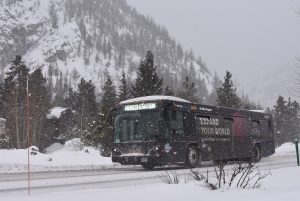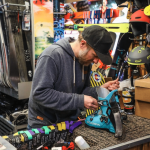Summit County voters could see a ballot measure in fall 2026 to create a regional transit authority

Kit Geary/Summit Daily News
Summit County could follow in the footsteps of the Roaring Fork and Eagle valleys in forming a regional transit authority, one that would likely include some neighboring communities.
While discussed at several municipal and county meetings throughout the past couple years, the idea is now getting some real legs. Voters in Summit County will have the final say via a ballot measure tentatively slated for November 2026.
A presentation at a Tuesday, Aug. 26, Breckenridge Town Council meeting shed light on the options officials have in front of them to put on a ballot.
Consultant Bill Ray said transit authorities are meant to improve a region’s transportation, and there’s a variety of mechanisms that can be tapped into and different forms it could take. Leading up to a vote, his firm plans to conduct community polling to gauge what voters want to see. Then, he said, jurisdictions will then jointly decide on a ballot measure.
He said with voter approval, a regional transit authority becomes a local government led by a board of elected officials with the ability to seek funds from taxes or by issuing bonds. The authority is bound by the Taxpayer Bill of Rights and can’t levy taxes without voter approval, and funding can also come from fees not approved by voters, he said.
A transit authority can use funding to tackle projects including adding more frequent service on existing routes, creating more direct connections within an existing transit system and improving roadway safety. Ray said what projects, and if an approved authority could absorb Summit Stage, remains to be decided.
They also can create new transit services to connect to unserved areas. Ray said an authority serving Summit County can loop in other communities like Kremmling, or an authority can be created to serve across several counties. For instance, the Roaring Fork Transportation Authority serves parts of Pitkin, Garfield and even Eagle counties.
Ray said officials have a few blue prints they can draw inspiration from, and he said one stands out from the rest.
“(The Roaring Fork Transportation Authority) is probably the highest functioning transit system in a mountain or rural community in our whole country, he said. “It is the diamond-encrusted, gold-plated example.”
The Roaring Fork’s authority involves fares riders must pay. Alternatively, he said the county could model their authority after Eagle County’s transit authority, including free services.
What Summit County voters could be asked to approve
Each town in Summit and unincorporated areas would have a vote to actualize the authority, but approval from every town isn’t needed. Council member Marika Page wondered if opposing communities can still get service. Ray said they can, such as the town of Gypsum.
Voters in every Eagle County community except Gypsum approved the creation of Eagle Valley’s Core Transit authority in 2022. Ray said in these situations, the transit authority can contractually serve the community, and require funding from them, but that community will not have a seat on the authority’s board.
Council member Carol Saade asked Ray how filling that board works given the authority’s status as a local government. He said board members are existing elected officials who are appointed by the jurisdictions they represent. Colorado law mandates a minimum of elected officials on the board, and every member of the authority must have an official on the board.
Ray said there’s also opportunities to create advisory communities within the authority that can include representation from the area’s major employers, like Vail Resorts. He added special districts like school and fire districts can also participate in different capacities.
Potential funding options
Ray said once a concept for how the authority will function is solidified, local officials with the help of consultants will have to determine if existing funding streams will be adequate to run the authority or if more will be needed.
A staff memo for the Aug. 26 meeting provided examples of different funding strategies that include: a sales tax of no more than 2% on every transaction excluding groceries and utilities, an annual motor vehicle registration fee of no more than $10 per vehicle, a visitor benefit tax of no more than 2% of the price of an accommodation, or a property mill levy of no more than 5 mills. Bonds, federal and state grants, and public-private partnerships are also available funding mechanisms. Ray said many state and federal funding opportunities favor regional entities serving several populations, and he added that transit authorities typically have strong odds of securing grants.
He said funding issues have brought turbulence to other regional transit authorities, noting how Steamboat Ski Resort reneged a $20 million pledge to fund the Yampa Valley’s planned authority for Routt and Moffat counties and opted for a three-year, $1-million-per-year commitment after the fact.
Council members questioned how funding questions could appear on a ballot.
Ray said there’s a few options. He said Eagle County municipalities put two items on the ballot when first introducing the authority, the first asked voters if they approved its creation and the second asked voters if they approved a half penny sales tax to fund it. He said this doesn’t have to be the case and those ballot measures could have been introduced in different years. He said this is what the town of Yampa plans to do in relation to its planned regional transit authority.
He said while Roaring Fork Transportation Authority systems have fares, they don’t fully cover the costs of the authority and other funding sources are needed.

Support Local Journalism

Support Local Journalism
As a Summit Daily News reader, you make our work possible.
Summit Daily is embarking on a multiyear project to digitize its archives going back to 1989 and make them available to the public in partnership with the Colorado Historic Newspapers Collection. The full project is expected to cost about $165,000. All donations made in 2023 will go directly toward this project.
Every contribution, no matter the size, will make a difference.









